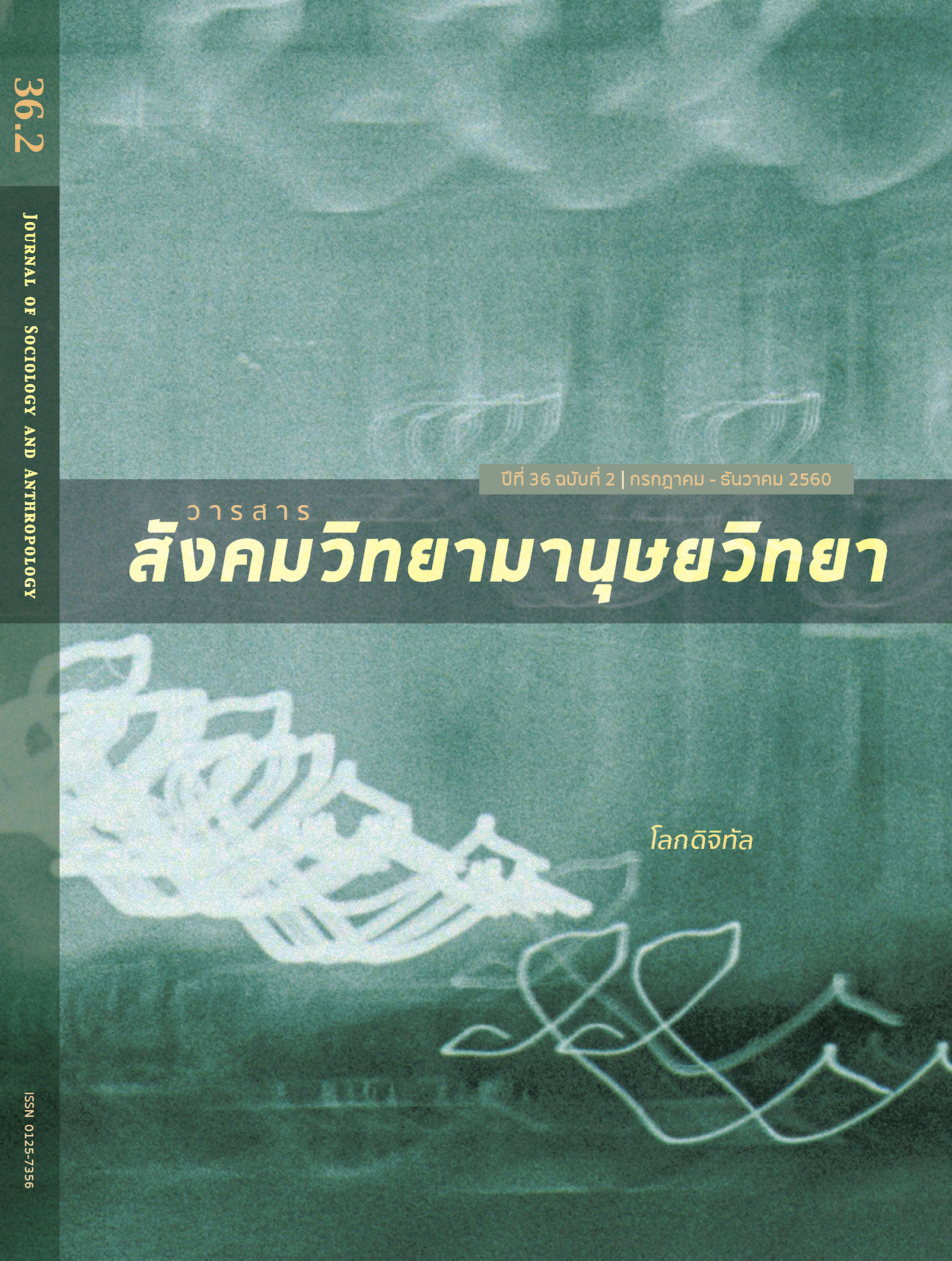“นักพักผ่อนหย่อนใจเต็มเวลา”: ผู้สูงอายุกับการจัดการเวลาว่าง ที่ล้นเกินใน “คาราโอเกะสูงวัย”
คำสำคัญ:
ผู้สูงอายุ, วัฒนธรรมสูงวัย, เวลาว่าง, คาราโอเกะ, เทคโนโลยีดิจิทัลบทคัดย่อ
บทความนี้ศึกษาการใช้เวลาของผู้สูงอายุในพื้นที่ที่ผู้เขียนเสนอให้เรียกว่า “คาราโอเกะสูงวัย” ซึ่งเปิดให้บริการเฉพาะช่วงกลางวันและเป็นพื้นที่ที่ผู้สูงอายุนิยมมาใช้เวลาตลอดทั้งวัน โดยอาศัยการสังเกตการณ์และสัมภาษณ์ผู้ประกอบการและผู้ใช้บริการในคาราโอเกะสูงวัยสองแห่งในเขตกรุงเทพมหานคร บทความนี้เสนอว่า สำหรับผู้สูงอายุในสังคมอุตสาหกรรม การใช้บริการคาราโอเกะเป็นวิธีหนึ่งในการจัดการกับเวลาว่างที่มีอย่างล้นเกินหลังเกษียณ ทำให้พวกเขาได้ทำกิจกรรมกับกลุ่มร่วมวัย ตลอดจนเพลงลูกกรุงที่นิยมร้องในสถานบริการคาราโอเกะเหล่านี้ ได้ช่วยผูกโยงคนเมืองสูงวัยผู้พลัดสมัยกับวันเวลาที่เป็นส่วนหนึ่งของชีวิตในอดีตของพวกเขา นอกจากนี้ การใช้อุปกรณ์ดิจิทัลต่างๆ ในการร้องคาราโอเกะยังมีส่วนช่วยขยายขอบเขตของการพักผ่อนหย่อนใจให้เป็น “การพักผ่อนหย่อนใจอย่างเอาจริงเอาจัง” ด้วย
เอกสารอ้างอิง
จุฑารัตน์ ประเสริฐ. 2557. “พฤติกรรมการใช้แอพพลิเคชั่นไลน์กับการรับรู้ตนเองและการสร้างความสัมพันธ์กับผู้อื่นของผู้สูงอายุไทย.” วิทยานิพนธ์นิเทศศาสตรมหาบัณฑิต (นิเทศศาสตร์), จุฬาลงกรณ์มหาวิทยาลัย.
ฉกาจ ราชบุรี. 2537. “ประวัติศาสตร์ธุรกิจเพลงลูกทุ่งไทย พ.ศ. 2507-2535.” วิทยานิพนธ์ศิลปศาสตรมหาบัณฑิต (ประวัติศาสตร์), มหาวิทยาลัยธรรมศาสตร์.
ปิ่นแก้ว เหลืองอร่ามศรี. 2553. “วัฒนธรรมวัยรุ่น.” สังคมศาสตร์ 22(1): 25-52.
พัฒนา กิติอาษา. 2553. “ดนตรีอีสาน แรงงานอารมณ์ และคนพลัดถิ่น.” ใน ผู้คน ดนตรี ชีวิต เล่ม 2: เสียงของประเทศไทย, บรรณาธิการโดย สุวรรณา เกรียงไกรเพ็ชร์, สรินยา คำเมือง, กมลทิพย์ จ่างกมล, และ อลงกต วรรณวิชัยกุล, 141-223. กรุงเทพฯ: ศูนย์มานุษยวิทยาสิรินธร (องค์การมหาชน).
ยศ สันตสมบัติ. 2540. มนุษย์กับวัฒนธรรม. พิมพ์ครั้งที่ 2 แก้ไขเพิ่มเติม. พิมพ์ซ้ำ, กรุงเทพฯ: สำนักพิมพ์มหาวิทยาลัยธรรมศาสตร์.
วิศปัตย์ ชัยช่วย. 2560. “การใช้ LINE ของผู้สูงอายุ: การศึกษาเชิงปรากฏการณ์วิทยา.” Veridian E-Journal, Silpakorn University สาขามนุษยศาสตร์ สังคมศาสตร์ และศิลปะ 10(1): 905-918.
ศิริพร แซ่ลิ้ม. 2558. “พฤติกรรมการใช้ไลน์แอพพลิเคชั่นของผู้สูงอายุในเขตกรุงเทพมหานคร.” วิทยานิพนธ์วารสารศาสตรมหาบัณฑิต (สื่อสารมวลชน), มหาวิทยาลัยธรรมศาสตร์.
สมสุข หินวิมาน. 2558. ว่างยังวุ่น: ชนชั้น เพศสภาพ และเวลาว่างของผู้หญิง. กรุงเทพฯ: พารากราฟ.
สุจิตต์ วงษ์เทศ. 2538. “เพลงลูกทุ่ง.” ใน เลิศชาย คชยุทธ. ไทยลูกทุ่ง, ไม่ระบุเลขหน้า. กรุงเทพฯ: มติชน.
เอนก นาวิกมูล. 2527. เพลงนอกศตวรรษ. พิมพ์ครั้งที่ 3 แก้ไขเพิ่มเติม. พิมพ์ซ้ำ, กรุงเทพฯ: เมืองโบราณ.
เอกสารภาษาอังกฤษ
Adorno, Theodor. 1991. The Culture Industry: Selected essay on mass culture. edited with an introduction by Jay M. Bernstein. London: Routledge.
Asian Development Bank. 2015. Thailand: Industrialization and economic catch-up. Mandaluyong City, Philippines: Asian Development Bank.
Best, Shaun. 2010. Leisure Studies: Themes and perspectives. London: Sage.
Boontarig, Waransanang, Wichian Chutimaskul, Vithida Chongsuphajaisiddhi, and Borworn Papasratorn. 2012. “Factors Influencing the Thai Elderly Intention to Use Smartphone for e-Health Services.” Proceeding of 2012 IEEE Symposium on Humanities, Science, and Engineering Research, 242-246, Kuala Lumpur, Malaysia, June 24-27.
Elias, Norbert and Eric Dunning. [1986] 2008. Quest for Excitement: Sport and leisure in the civilising process. Revised edition, vol. 7 of The Collected Works of Norbert Elias, edited by Eric Dunning. Dublin: University College Dublin Press, 2006-2014.
Huber, Lesa Lorenzen, Kalpana Shankar, Kelly Caine, Kay Connelly, L. Jean Camp, Beth Ann Walker, and Lisa Borrero. 2013. “How In-Home Technologies Mediate Caregiving Relationships in Later Life.” International Journal of Human-Computer Interaction 29(7): 441-455.
Loe, Meika. 2010. “Doing It My Way: Old women, technology, and wellbeing.” Sociology of Health & Illness 32(2): 319-334.
Long, Susan O. 2012. “Bodies, Technologies, and Aging in Japan: Thinking about old people and their silver products.” Journal of Cross-Cultural Gerontology 27(2): 119-137.
Reddy, Peter, Irundika Dias, Carol Holland, Niyah Campbell, Iaysha Nagar, Luke Connolly, Peter Krustrup, and Harry Hubball. 2017. “Walking Football as Sustainable Exercise for Older Adults–A Pilot Investigation.” European Journal of Sport Science 17(5): 638-645.
Sakdulyatham, Raywadee, Somjaree Preeyanont, Rajalida Lipikorn, and Rewadee Watakakosol. 2017. “User Interface on Smartphone for Elderly Users.” International Journal of Automation and Smart Technology (AUSMT) 7(4): 147-155.
Thompson, Edward Palmer. 1967. “Time, Work-Discipline, and Industrial Capitalism.” Past & Present 38: 56-97.
เอกสารออนไลน์
นิตยสารผู้จัดการ. 2536. “ดิโอลด์สยาม พลาซ่า บทพิสูจน์ฝีมือสยามพาณิชย์ฯ.” นิตยสารผู้จัดการ, พฤษภาคม 2536. http://info.gotomanager.com/news/details.aspx?id=5951. สืบค้นวันที่ 13 ธันวาคม 2560.
วิโรจน์ จุนประทีปทอง. ม.ป.ป. “ประวัติ.” ตั้งฮั่วเส็ง. http://www.tanghuaseng.com/cms_aboutus.html. สืบค้นวันที่ 31 ตุลาคม 2560.
matemate. 2559. “ทำไม ‘ตั้งฮั่วเส็ง’ ห้างสรรพสินค้ายุคดั้งเดิม ยังเติบโตเคียงข้างคนไทยมา 55 ปี.” Brand Inside, 18 ตุลาคม 2559. https://brandinside.asia/tang-hua-seng-department-store. สืบค้นวันที่ 31 ตุลาคม 2560.
Anderson, Monica and Andrew Perrin. 2017. “Tech Adoption Climbs Among Older Adults,” Pew Research Center, May 17, 2017. http://www.pewinternet.org/2017/05/17/tech-adoption-climbs-among-older-adults. Accessed December 5, 2017.
World Bank. 2016. “Thailand Economic Monitor: Aging society and economy–June 2016 (English).” Working Paper No. 107267, World Bank, Bangkok, Thailand. Accessed December 5, 2017. http://documents.worldbank.org/curated/en/830261469638312246/Thailand-economic-monitor-aging-society-and-economy-June-2016.



